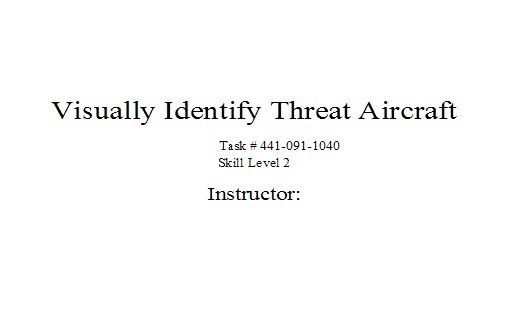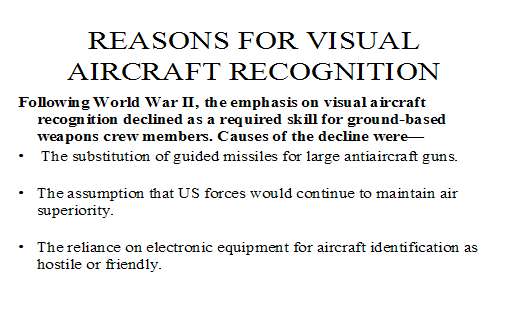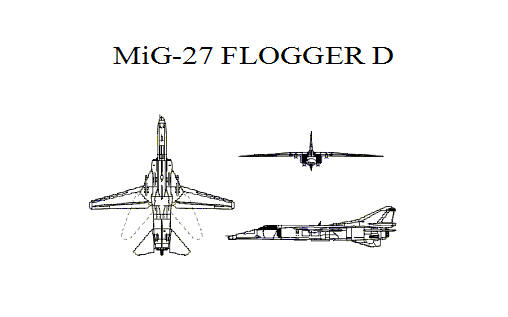Visually Identify Threat Aircraft
Click here to download the presentation.



Visually Identify Threat Aircraft Task # 441-091-1040
Skill Level 2
Instructor:
REASONS FOR VISUAL AIRCRAFT RECOGNITION
Following World War II, the emphasis on visual aircraft recognition declined as a required skill for ground-based weapons crew members. Causes of the decline were-
The substitution of guided missiles for large antiaircraft guns.
The assumption that US forces would continue to maintain air superiority.
The reliance on electronic equipment for aircraft identification as hostile or friendly.
REASONS FOR VISUAL AIRCRAFT RECOGNITION Cont’d
The need for visual aircraft recognition skills has become more critical since-
An analysis of past military actions shows aircraft losses to air defense guns and small arms. It has reestablished that the soldier on the ground is capable of inflicting heavy losses on aircraft operating at low altitudes.
Continued air superiority over every battlefield is not possible.
Electronic identification has limitations and small units or individual soldiers do not always have access to these devices.
REASONS FOR VISUAL AIRCRAFT RECOGNITION Cont’d
Visual recognition and identification of specific aircraft types and timely reporting provide the S2 and G2 additional information of an air threat, or information on supply drops, defoliation, or photographic reconnaissance.
The provision of large numbers of AD weapon systems to all divisional and some nondivisional ground combat forces generates additional emphasis on the need for visual aircraft recognition. Crew and team members of these weapon systems depend on visual recognition and identification of aircraft when making engagement decisions.
Factors That Affect Detection, Recognition, and Identification
Every attempt made at visual aircraft recognition involves two events. First, an aircraft must be detected. Second, the aircraft must be inspected to distinguish the characteristics or shape that makes it recognizable as a particular aircraft.
Since detection, identification, and recognition are all visual processes, an aircraft must be detected, and then recognized at the farthest range possible, to make a timely engagement decision and or to report the aircraft. The task requires good, corrected if necessary, eyesight.
EARLY AIRCRAFT RECOGNITION AND IDENTIFICATION
The farther out an aircraft can be detected, recognized, and identified, the more time a gunner has to make an engagement decision. If the gunner is not going to engage the aircraft, then early recognition and identification will allow time to seek cover and or report the aircraft. The importance of early identification is demonstrated in the following illustration.
AIRCRAFT RECOGNITION AND IDENTIFICATION FEATURES
All aircraft are built with the same basic elements: wings to provide lift, engine(s) to provide motive power, a fuselage to carry the payload and controls, and a tail assembly which usually controls the direction of flight. The differences distinguish one aircraft type from another. The WEFT Features illustration shows wings, engine(s), fuselage, and tail features of aircraft.
Ground-Attack, Close Air Support,
and Fighter-Bomber Aircraft
MiG-27 FLOGGER D
MiG-27 FLOGGER D
MiG-21 FISHBED
MiG-21 FISHBED
MiG-29 FULCRUM
MiG-29 FULCRUM
Su-24 FENCER
Su-24 FENCER
Su-17/20/22 FITTER
Su-17/20/22 FITTER
Helicopter Aircraft
Mi-2 HOPLITE
Mi-2 HOPLITE
Mi-28 HAVOC
Mi-28 HAVOC
Mi-6 HOOK
Mi-6 HOOK
Mi-26 HALO
Mi-26 HALO
Mi-4 HOUND
Mi-4 HOUND